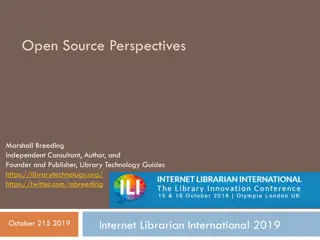International Collaboration in Open Source Software: A Network Analysis Study
This research project delves into the realm of open source software (OSS) by using web scraping and network analysis to understand international collaboration dynamics. It explores the significance, scope, and impact of OSS, focusing on the structure of collaboration networks, contributions of different countries, and the evolution of collaborations over time. By employing network analysis, the study aims to uncover patterns of individual and country-to-country collaborations in the OSS ecosystem.
Download Presentation

Please find below an Image/Link to download the presentation.
The content on the website is provided AS IS for your information and personal use only. It may not be sold, licensed, or shared on other websites without obtaining consent from the author.If you encounter any issues during the download, it is possible that the publisher has removed the file from their server.
You are allowed to download the files provided on this website for personal or commercial use, subject to the condition that they are used lawfully. All files are the property of their respective owners.
The content on the website is provided AS IS for your information and personal use only. It may not be sold, licensed, or shared on other websites without obtaining consent from the author.
E N D
Presentation Transcript
Using Web Scraping and Network Analysis to Study International Collaboration in Open Source Software Brandon L. Kramer1Gizem Korkmaz1 J. Bayo n Santiago Calder n2 Carol A. Robbins3 1 2 3 Federal Committee on Statistical Methodology 2021 Research and Policy Conference This work is supported by the National Center for Science and Engineering Statistics (49100420C0015). The views expressed in this work are those of the authors and not necessarily those of their respective institutions. 1 / 23
Project Background Presentation Overview Project Background Open Source Software International Collaboration Data & Methods Data Collection & Classification Networks Construction OSS International Collaboration Contributor networks Country-to-country networks 2 / 23
Project Background What is Open Source Software? Software that is published under an Open Source Initiative (OSI) approved license OSI-approved licenses establish permissions (e.g., use, inspect, modify, distribute, attribution) and limitations (e.g., liability, warranty) Most common licenses are: MIT, Apache, GPL, BSD, etc. Prominent OSS examplesinclude: Apache, Linux, Mozilla, R, etc. Past work has conducted network analysis of either single projects and/or smaller-scale networks of code hosting platforms like GitHub 3 / 23
Project Background The Scope and Impact of OSS Current NCSES and other economic indicators do not measure the scope and impact of open source software developed outside the business sector.1 Scope and Value: How much open source software is in use? Who creates these products? How can we measure the value of open source software? Collaboration Networks: What is the structure of OSS collaboration networks? How do collaborations span across geographic boundaries? 1S. Keller, G. Korkmaz, et al. Opportunities to observe and measure intangible inputs to innovation: Definitions, operationalization, and examples . In: Proceedings of the National Academy of Sciences 115.50 (2018), pp. 12638 12645. 4 / 23
Project Background International Collaboration International collaboration doubled in academic papers since 1990 More governmental funding for projects that developed through international collaboration tend to lead to higher impact publications Understanding international contributions in the context of OSS will help explain: Which countries are most likely to contribute to OSS? Which countries are most likely to collaborate internationally? What is the structure of international collaboration and how does it change over time? Which are the most influential countries in the OSS ecosystem? Using network analysis to study: Individual and country-to-country collaborations 5 / 23
Data & Methods Data Collection Developed GHOST.jl to scrape commit data Package developed for targeted scraping of GitHub user and activity data using the GitHub v4 GraphQL API Find public repositories with an OSI-approved license Collect development activity information (e.g., commits, additions) Used GHTorrent to classify contributors Commit data supplemented with user data from GHTorrent2 User data includes login, email, location and company information Developed algorithm to convert location data to country codes 2Georgios Gousios. The GHTorrent dataset and tool suite . In: Proceedings of the 10th Working Conference on Mining Software Repositories. MSR 13. San Francisco, CA, USA: IEEE Press, 2013, pp. 233 236. 6 / 23
Data & Methods Tools for Scraping OSS Data GHOST.jl* Julia package used for targeted scraping of commit activity data tidyorgs* R package used for organizational and sectoring classification diverstidy* R package used for geographic and population classification PyGithub Python package used for scraping user and repository attributes * Developed at UVA SDAD 7 / 23
Data & Methods Data Summary: Contributors Our original dataset is comprised of 3.3M distinct contributors and 7.8M distinct repositories To examine international collaborations, we reduced the dataset to only include logins with valid country codes, which included 733K contributors and 3.5M repositories dating from 2008 to 2019 8 / 23
Data & Methods Network Data To convert these data into network format, we projected a bipartite login-repository network into single-mode contributor networks The contributor network is comprised of Nodes represent contributors Edges correspond common repositories that users contribute The country-country network is comprised of Nodes represent countries Edges correspond to international collaborations Analyzed networks using R s igraph and ggraph as well as Gephi 9 / 23
Results International Collaboration Tendencies US engages in domestic collaboration more than other top countries Top countries collaborate with US developers more than domestic colleagues 10 / 23
Results Longitudinal Trends Marked contrast with exponential growth of contributor networks Countries join the network until around 2013 Collaborations steadily rise while commits increase exponentially The number of communities fluctuate in a way that clearly depends on the upper threshold of countries 11 / 23
Results Longitudinal Trends The density, transitivity, modularity, and mean distance all reflect a similar shift around 2013 12 / 23
Results Community Detection Analyses 13 / 23
Results Community Detection Analyses The inclusion of domestic collaborations (loops) in our community detection analyses revealed regional collaboration tendencies 14 / 23
Results Community Detection Analyses Regional communities formed between Nordic, African, South American, and former-Soviet countries 15 / 23
Results Comparing Centrality Measures Comparing betweenness centrality vs. degree centrality shows more relative brokering capacity for the US, Canada, China, Nigeria and Kenya 16 / 23
Results Comparing Centrality Measures Examining average betweenness centrality over time reveals that top countries have started yielding influence 17 / 23
Main Takeaways Main Takeaways GitHub Contributor Networks US-based users are most likely to contribute to GitHub Country-to-Country Networks Network growth affected by upperbound of countries in the world Centrality measures reveal that some countries (like the USA) have more influence in the OSS ecosystem The country-country network clusters into regional communities, reflecting a likely combination of socio-political and economic factors that shape OSS development Policy Implications Use of SNA can help the federal government monitor the level of incoming and outgoing OSS projects as well as their economic value by capturing international collaboration dynamics over time. 18 / 23
Main Takeaways Q&A Questions? 19 / 23
Main Takeaways Summary of Scraped GitHub Data 20 / 23
Main Takeaways Summary of Scraped GitHub Data 21 / 23
Main Takeaways Summary of Results Country USA China Germany UK India Canada Brazil France Russia Japan Descriptive Statistics for Top-10 Countries Based on Users, GitHub 2008-19 Users 216K 54K 40K 40K 37K 27K 25K 25K 22K 16K Repos 1.2M 289K 298K 271K 160K 174K 142K 173K 120K 130K R/U Commits 5.3 5.3 7.4 6.8 4.3 6.4 5.7 7.0 5.5 8.2 C/R Adds 37.5 22.9 38.2 34.8 16.9 29.4 20.0 34.7 28.5 29.9 A/C Dels 1531.6 2080.1 986.8 1191.6 2615.7 1449.9 2115.4 1287.2 1063.5 955.9 D/C TotColabs 621.5 633.5 452.8 550.0 684.5 585.9 749.5 499.2 435.6 390.4 DomColabs USColabs 26.4% 33.2% 30.1% 32.6% 33.2% 33.9% 29.0% 28.0% 27.6% 32.6% 43.0M 6.6M 11.4M 9.4M 2.7M 5.1M 2.8M 6.0M 3.4M 3.9M 65.9B 13.7B 11.2B 11.2B 7.1B 7.4B 6.0B 7.8B 3.6B 3.7B 26.7B 4.9B 5.2B 5.2B 1.9B 3.0B 2.1B 3.0B 1.5B 1.5B 2.4M 339K 790K 548K 306K 335K 165K 375K 197K 205K 26.4% 14.9% 9.0% 8.2% 6.9% 4.5% 6.2% 6.4% 5.9% 6.7% The table shows US-based contributors higher number of users, repos, commits, and overall collaborations relative to other countries in the network. We also observed substantial country-level variability in the number of repos per user (R/U), the commits per repo (C/R), as well as the additions (A/C) and deletions per commit (D/C). 22 / 23
Main Takeaways Summary of Results Comps K-Core 15 18 18 15 13 22 20 24 22 18 12 18 Btw GCent 22.1 23.6 34.1 46.6 58.4 64.5 68.7 65.1 64.9 68.0 67.7 64.0 GBtw 0.170 0.125 0.117 0.159 0.142 0.101 0.107 0.087 0.060 0.052 0.042 0.035 Year 2008 2008-09 2008-10 2008-11 2008-12 2008-13 2008-14 2008-15 2008-16 2008-17 2008-18 2008-19 Longitudinal Descriptive Analysis of Country Networks, GitHub 2008-19 (Cmtys=Communities, Comps=Components, Btw=Betweenness) Nodes Edges Commits 1183 1713 2220 3028 3939 4944 5992 7160 8177 9270 10565 11294 Triads Cmtys 11K 20K 30K 45K 64K 87K 120K 161K 199K 245K 314K 348K Dens 0.289 0.308 0.273 0.260 0.253 0.230 0.251 0.272 0.295 0.323 0.365 0.391 Trans 0.725 0.742 0.734 0.696 0.657 0.633 0.646 0.657 0.657 0.667 0.697 0.696 Mod Dist 0.001 0.003 0.003 0.002 0.002 0.002 0.001 0.001 0.000 0.001 0.003 0.002 Deg 24.0 30.3 32.7 37.6 42.5 45.5 52.7 60.3 67.3 75.2 85.7 91.7 91 106 128 153 177 208 219 230 236 240 241 241 123K 320K 688K 1.3M 2.3M 4.0M 6.5M 10.5M 15.8M 22.0M 28.9M 34.7M 36 35 41 38 35 50 46 52 53 52 48 45 33 38 45 51 55 59 63 70 74 81 90 93 1.669 1.624 1.703 1.733 1.755 1.763 1.748 1.695 1.665 1.653 1.619 1.586 0.533 0.511 0.546 0.601 0.633 0.611 0.616 0.601 0.594 0.572 0.539 0.534 At the country-level, the network moves through two growth periods marked first by rapid growth before all countries join the network. After 2013, the network becomes moredenseand moretransitive asthe number of distinct communities drops and communities of OSS collaboration form around specific geographical regions. 23 / 23























